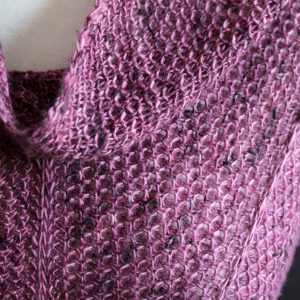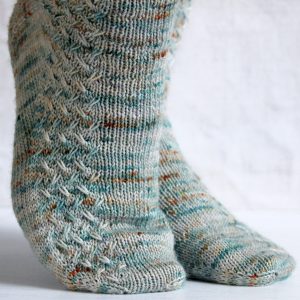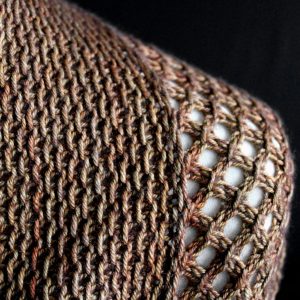What Happened
On June 16th Cassidy unleashed a brand new look for Ravelry. This new look changed the colour scheme, font, line spacing, rearranged menus and added animations to the login and purchase pages. There was no warning, no mention that it was coming and happened literally on the refresh of a page. Consider for a minute the stress that this would cause to a neurotypical person when a site that you’ve used regularly over many years (daily for a lot of users) suddenly changes significantly without warning, and then consider that Ravelry has a large number of neurodiverse users to whom these changes were even more alarming and confusing. These changes have caused harm to disabled and able-bodied users. Screen readers could no longer navigate the site. Many users suffered eye strain and headaches, some nausea and vertigo, some migraines and most worrying of all a few suffered seizures. These are known effects and can be linked to bright contrast, colour and a flashing effect as pages load or are scrolled (see Web accessibility for seizures and physical reactions for more information). My personal experience was headaches the first couple of days when I only used Ravelry for a couple of minutes at a time, then on the third day, after attempting to use the site for half an hour I got the worst migraine I’ve had in years. I spent eight hours lying down in a dark room, with a stabbing headache every time I moved, nausea, and unable to do anything. (Silvia Maggi has written an interesting blog post from the point of view of a User Experience Designer (the same role that Livia holds at Ravelry) about the issues, how they could have been avoided and with links to many articles on these issues: How Rebranding Cost Ravelry the Trust of Their Community)
After three days, the Rav team introduced the option to change back to the “classic” look of the site. At this point, I was able to log in, read the forums, see how widespread the issues were and how many people were being adversely affected. A couple of other changes were made to the font and line spacing, and some of the black lines on the forums were replaced with grey ones. We were given the option to turn off the black drop shadows in our settings. It took ten days before the animation on the login screen was finally stopped and people could log in without it causing them problems. The other changes have all been in our personal settings. This means that anyone who is not logged in who follows a link to Ravelry (eg, through the IG app, when using a library computer or anyone without a Ravelry account) will get the migraine-inducing, seizure-causing website. This is potentially dangerous for anyone stumbling across the site. Some people are still unable to navigate past the highly contrasted log in page to use the site, and many users now find that the “classic” view of the site is also causing them eye-strain and headaches. It has since come out that testing was only done over six weeks, with just 100 testers (which is a tiny sample for a website that boasts 9 million users, with approximately 900, 000 being active on a monthly basis) and while many of those testers have come forwards to say they reported suffering eyestrain, headaches and migraines from the new look, no changes were made before it was launched.
Ravely’s Response
Ravelry’s response has been to block any discussion of accessibility issues on the website. They invite users to send them emails, but although they respond promptly to bug reports, to my knowledge no one has had a reply to emails about accessibility problems. They have also closed comments on their Instagram account, deleted comments on their Facebook page, and are not responding on Twitter. They have created two surveys, the first had many GDPR issues as it was linked to a users account and asked users to describe any medical problems or issues they had. The survey asked opinions on the new logo, colours, the new navigation bar and the users’ medical history. These questions all had open text boxes with no limit on the number of words that could be entered. The final box for “other comments” was limited to 500 characters, leaving very little room for anyone to talk about accessibility.
Next, they put up a blog post starting with “For those of you who are having issues with the New Ravelry design, we’re truly sorry that aspects of the site are not usable for you. Your experience on Ravelry matters so much to us, and we're working hard to make our site work as well as possible for all of you.” (issues being migraines and seizures, “some aspects” being can’t look at it at all), then told us their automatic web checker said accessibility was better than ever (the automatic checker cannot check things like colours, contrast or brightness, and is mostly limited to checking everything has alt text and a screen reader can see it), before transitioning to tell us it was they have more sign-ups than last June, and 92% of active users are using the “new” look, with no definition of what an active user is. This subtly conveys the opinion that it’s just a few people who are complaining so it’s not really that important and look, lots of shiny new users to replace the old ones!
Nearly two weeks later the Ravelry team produced a new “readability survey”. This survey offered various different options for the look of certain aspects of the site. It’s worth noting that after asking whether you had drop shadows turned on or off at the start, every image of the buttons within the survey showed them with drop shadows. The survey gave different options for font, background colour, footer bar colour, and button colours. These were repeated in different combinations. While this allows for comparisons between the various options, it made the test very long, and the screenshots of the site used in the test triggered the same headache and migraine responses as the website does, meaning that many of those who most need the changes were unable to complete the survey. The survey was closed after 10 days with “over 10,000 completed surveys”. A week later (July 24th) it was announced that “Ravelry customisations based on the survey data and feedback received” are being designed. This is problematic because if the changes are only to users personal settings, as I said before, anyone who is not logged in who follows a link to Ravelry will get the migraine-inducing, seizure-causing website.
Actions from Ravelry’s Staff
There have been more problems directly from the Ravelry staff. Over the last six weeks, Mary-Heather has been asked repeated not to use the new icons as bullet points (and to just use the normal black dots instead) in both blog posts and forum posts. These icons cause visual difficulties for some and cause screen readers difficulties. She continues to use them in every post about site updates.
Katie (@ktb38 on Instagram) was featured as a Human of Ravelry on their blog in February for all her work in advocating for size inclusion (including grading garments and other items for a larger range of sizes, particularly those in the plus-size range). She was asked to help the Ravelry team find ways that they could support size inclusion through the database. Since the changes to Ravelry, Katie has also been advocating for accessibility for all those who have lost access to Ravelry. She’s been keeping everyone informed about any changes, listening to stories from those affected, and recently ran a poll asking if designers had noticed a fall in sales. She made an Instagram post with the survey results, clearly stating that “75% of the designers who answered the poll had seen a fall in sales”. Cassidy’s (co-founder and developer of Ravelry) was to tweet about her, saying “There’s a person on Instagram who has been spreading straight up lies about Ravelry non-stop since we have updated the design. The most recent one is that pattern sales are down. No. This has been the best July ever.” You can see a screenshot of the tweet here. Cassidy has since deleted her Twitter account after criticism of the tweet. Now, this implies Cassidy does not believe in the accessibility issues that users have been facing over the last six weeks, which is extremely concerning and greatly diminishes any hope of real progress being made. Cassidy is also calling every designer who answered the survey a liar and let’s remember one really important point - there are thousands of designers on Ravelry, a very large percentage of whom do not earn enough to pass the threshold to pay Ravelry fees. It’s possible for a large number of small designers on Ravelry to lose sales, while a small number of the bigger name designers have a great month and lift Ravelry’s sales numbers as a whole. For the co-founder of the site to attack a user who is advocating for those who have lost access to Ravelry is appalling and has seriously damaged the little trust that many members had left.
Why This Has Harm Users and Damaged Trust
During a global pandemic, when millions of people around the world are self-isolating, and disabled users are even more isolated than normal, Ravelry’s new look has taken away users access to their friends, social networks and support systems. The loss of access to Ravelry has meant that some users cannot access the pdf patterns they have bought, and cannot use the database to look for patterns, choose yarns, see projects in different sizes or access their project notes. Ravelry has set itself up as the ultimate database and community for fibre crafters over the last decade, but now, for so many people, it’s gone. Ravely staff have proclaimed that they are an inclusive website. They’ve donated money to Black Lives Matter, stood up for LGBTQIA+ and supported size inclusivity but when it comes to access for the disabled members of Ravelry, they have been ignored, dismissed and, at best, treated as an afterthought.
For designers, many have been unable to access their own accounts. They cannot provide pattern support through the site any more. They are seeing a loss in income as users turn away from Ravelry. Many have had to find an alternate way of selling patterns (LoveCrafts, Etsy, Payhip), spending hours setting up these systems to support those that cannot access Ravelry and finding ways to send copies of patterns to those customers who cannot access their libraries. They have removed or put warnings on links to Ravelry to avoid causing harm to the unwary. Some have held back pattern releases and found alternate ways to host Knit-Alongs and pattern tests. Designers have cancelled advertising in protest, and many have even removed their pattern sales from Ravelry completely. Many of us are facing the decision of keeping our patterns on Ravelry, who are acting contrary to our own beliefs (or preventing us from accessing the site altogether), or removing them and losing our businesses.
What We Need
What we have been asking for, since the new look has gone live is for the site to be rolled back to the way it was on June 15th 2020. If this isn’t possible, we need “Classic Ravelry” to be the default (with bugs fixed), and the new look to be the opt-in option until the new look has been fixed, checked for accessibility and no longer harms users. This will protect users who are not logged in and new users, who follow a link to Ravelry will get the migraine-inducing, seizure-causing website. Ideally, they would hire an expert in accessibility web design to ensure that the site is as accessible for all users as possible. We would also like an apology to those users who have been harmed by the changes to the website and also to Katie for the harm they have done to her.
If you are a designer, please consider signing the Designer's Open Letter on Ravelry Accessibility . We can only hope that if enough people sign, it will have an impact.
If you aren’t a designer, please do try emailing them (contact-us@ravelry.com), expressing your support for those members who are being harmed and cannot access Ravelry, and asking them to make the website safe again.
I’m disabling comments on this post as the situation has moved on in the last couple of weeks. We sent the letter. Ravelry don’t want to change things. Please see my two more recent posts about where I am with regard to leaving Ravelry.






7 Comments on Ravelry and Accessibility
Very interesting insights, Liz and thank you for linking for post!
-Silvia
Thank you for your post! It was a really interesting read!
Hello, I have also sent comments to the team about their accessibility both about putting the ‘skip to content’ option on the new site only and about alt text on the site. I received two very constrasting replies one thanking me and another being very defensive and aggressive. I’ll leave you to work out who the second one was from.
I’m sorry you were on the receiving end! I can guess who it was from.
Oh please, I have 25 years of working with accessibility and I have never in my entire life seen so many that have so much problems about this matter. Yes, Ravelry changed their design, the new design is not good but the old wasn’t any better. The accessibility is as bad as before, they have literary just polished the surface, but give them a break. It is not your site, it is theirs.
I accept that the accessibility on the site has never been great, but the website was not causing migraines or seizures to a large number of its users before the changes, and some users with screen readers were able to use the site before. Accessibility decreased with the changes, many users were harmed, many designers can no longer use the site through which they sold their patterns leading to a loss of income for many. But the most damaging factor is that the staff of Ravelry consistently deny that the website causes physical harm to its users, leading to doubts that anything will be done to improve this. If they had reset the site to its previous look while working on the accessibility issues with the new look, then people would have had a lot less to say about it.
The whole episode has opened the eyes of many of us to the team’s previous failures around accessibility and ableism, and their failure to actually enforce their no hate speech policy, allowing racism and homophobic abuse in their forums. You can see my next two blog posts about leaving Ravelry if you’re interested.
I’m severely dyslexic, have a panic disorder and get migraines (in life). I usually use a screen reader and speech to text. I have had no problem using Ravelry in the past or now.
It would be great if nothing was ever a barrier to neurodivergent people, but that is not life. If we were talking access to healthcare information, school or requirements for my job, then I’m going to push back. But a totally optional website for my hobby? I’m not a victim because a knitting website uses a bad font.
These kinds of campaigns turn real disability rights situations into a joke, and/or companies and individuals just stop trying because it’s becoming impossible to achieve the bar. It has , ironically, become harder to be open about having a disability in the hiring process, because now companies worry that I will demand a host of expensive accommodations and when really I may need none or very simple things. Universities are now removing free content they provided to the public in the past, because of the manpower required to make everything accessible and they don’t want to be legally liable. Keep pushing and Ravelry may just decide to close down entirely, and while I’d hate to see that happen, I couldn’t blame them.
Comments are closed.